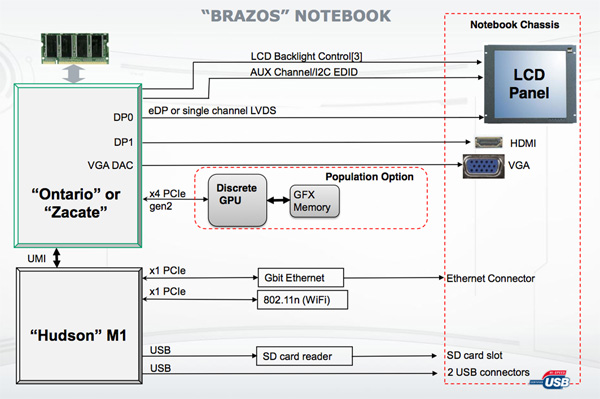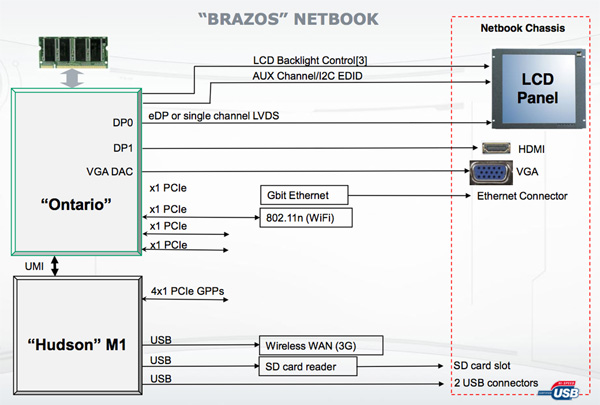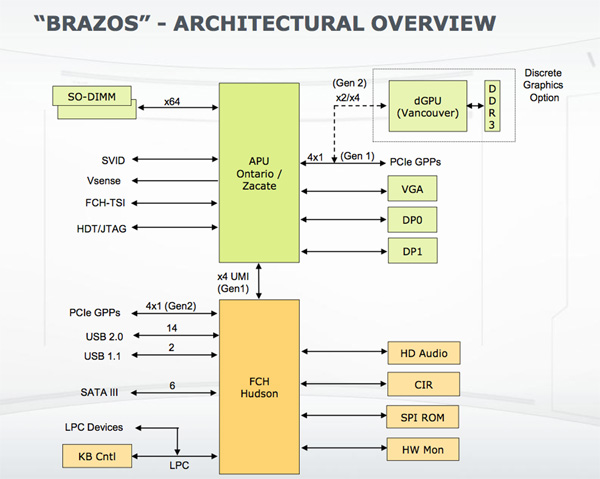Previewing AMD's Brazos, Part 1: More Details on Zacate/Ontario and Fusion
by Anand Lal Shimpi on November 9, 2010 1:09 AM ESTThe Chipset err...Fusion Controller Hub
The Zacate/Ontario APUs have an integrated PCIe interface sporting 8 lanes. Four of those lanes are used for AMD’s Universal Media Interface (UMI) - a bus that links the APU to the Hudson FCH. The remaining four can be used for discrete graphics or a combination of discrete graphics and other PCIe controllers. Both PCIe interfaces can run at gen 1 or gen 2 transfer rates.
Display output naturally stems off of the APU. You can drive two displays in tandem over any combination of VGA or Display Port/DVI/HDMI/LVDS.
As I mentioned earlier, the APU sports a single channel memory controller - but you can install up to two DIMMs on that channel. Speeds are down from the 1333MHz system we tested at IDF, DDR3-1066 is the max you’ll officially see on a Brazos system.
The Hudson FCH supplies up to 14 USB 2.0 ports, 6 x 6Gbps SATA ports and another 4 PCIe lanes. The FCH is based on AMD’s SB800 series of South Bridges. Despite the small size, this is a full featured platform.
From the looks of it, AMD has all of the right ingredients for some very competitive entries in the mainstream and ultraportable notebook markets. Now it’s just up to the OEMs to build something cool out of it.
Check back in about a week for the full rundown on Zacate performance.













106 Comments
View All Comments
flyck - Tuesday, November 9, 2010 - link
Don't forget the chip is manufactured on 40nm. I believe ontario platform released will be ok for the current market. The GF 28nm node for the next models will be the thing that will make ontario succeed or fail.Dark_Archonis - Tuesday, November 9, 2010 - link
By the time the next models on 28mm come out, Atom will be redesigned for out-of-order execution, and ultra low voltage Ivy Bridge models will likely be on sale at the low-end.mino - Tuesday, November 9, 2010 - link
Cheap Ivy Bridge, powerful yet low power Intel IGP, ... Atom faster that Bobcat ...I do not know what you are smoking, but it must be good.
There will be no cheap low power IB. Well, not before 2013.
Ontario #2 is here Q1 2012. How about that.
/end troll reply
Dark_Archonis - Tuesday, November 9, 2010 - link
Ontario #2 will be here Q1 2012? Really? Is that the one on the 28nm process? Somehow I doubt that AMD will release it at that time.Point is, I wouldn't be so sure of Bobcat being a huge success. Let's wait and see what happens shall we?
mino - Tuesday, November 9, 2010 - link
Yes, the 28nm one.Bobcat is the right design for the right market at the right time (even pulled in quarter!) for a great price.
There is possibly no way for it to not succeed. The question remains, how much.
Dark_Archonis - Tuesday, November 9, 2010 - link
Low-end laptops mostly use Celerons and Pentiums. I don't see Bobcat changing that situation much.Bobcat could do well with netbooks, except there is a problem. Netbook market share is declining, mainly due to the iPad.
So in reality, Bobcat has to compete not just with Intel, but also with Apple.
The only other viable market might be the HTPC market. That is not a very big market though, and Intel is pushing hard in that market as of now.
sprockkets - Tuesday, November 9, 2010 - link
Why? The whole point of atom is ultra low power usage in devices like phones where ARM dominates.Never going to happen.
Kiijibari - Tuesday, November 9, 2010 - link
You forget the fundamentally difference between Atom and Bobcat:Bobcat is a OoO CPU, Atom is a InOrder CPU.
Therefore Bobcat will have a much higher performance per clock. If 500 Mhz clock advantage is enough for Atom to beat Bobcat has to be seen.
You might compare that to the i5-760 vs. Phenom2 955/965 situation. Even though the Phenoms run at higher clocks, they are not faster as the lower clocked i5. That's because the i5 has a higher IPC, too. In that case not because of OoO <> InO, but that doesn't matter for the comparison.
mino - Tuesday, November 9, 2010 - link
Actually we have a wery good comparison available right on the market. It is even hinted in the article.Just take 1,3GHz CULV C2D, pair it with a lower clocked 5450 and we are in the ballpark of 18W ontario give or take 10%.
Now we just need to remember where Atom stands relative to C2D ...
Dark_Archonis - Tuesday, November 9, 2010 - link
Atom will improve, Intel won't be sitting still.